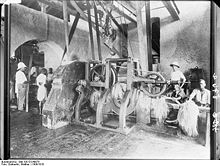- Decorticator
-
A decorticator (from Latin: cortex, bark) is a machine for stripping the skin, bark, or rind off nuts, wood, plant stalks, grain, etc., in preparation for further processing.
In 1861 a farmer named Bernagozzi from Bologna manufactured a machine called a "scavezzatrice," a decorticator for hemp[1]. A working hemp decorticator from 1890 manufactured in Germany is preserved in a museum in Bologna.[2] In Italy the "scavezzatrice" faded in the 1950s because of competition from synthetic materials and from other more profitable crops.
Probably hundreds of different decorticators have been developed since 1890.[3] Misconceptions spread about the device includes the suggestion that the first working hemp decorticator was invented in the US in 1935.[4] In 1916 there were already five different kinds of "machine brakes" for hemp in use in the US, and still others in Europe.[5]
One of the most discussed decorticators is the Schlichten model. Quoted from Hemp - American History Revisited by Robert Deitch copyright 2003 Algora Publishing:
“ ... because of the 1917 introduction of a machine designed by George Schlichten, known as the "Decorticator." The Decorticator separated the long hemp fibers from the pulpy celluloid (hurds) center of the hemp stalks, dramatically reducing the exorbitant labor costs associated with cleaning and preparing hemp for further processing. ” Quoted from The Emperor Wears No Clothes - The Authoritative Historical Record of the Cannabis Plant, Marajuana Prohibition & How Hemp can still Save the World! by Jack Herer copyright 1993 Green Planet Company Publishing:
“ Under old methods, hemp was cut and allowed to lie in the fields for weeks until it "retted" enough so the fibers could be pulled off by hand. Retting is simply rotting as a result of dew, rain and bacterial action. Machines were developed to separate the fibers mechanically after retting was complete, but the cost was high, the loss of fiber great, and the quality of fiber comparatively low. With the new machine, known as a decorticator, hemp is cut with a slightly modified grain binder. It is delivered to the machine where an automatic chain conveyer feeds it to the breaking arms at the rate of two or three tons per hour. The hurds are broken into fine pieces which drop into the hopper, from where they are delivered by blower to a baler or to truck or freight car for loose shipment. The fiber comes from the other end of the machine, ready for baling... Schlichten spent 18 years and £400,000 on the decorticator, a machine that could strip the fibre from nearly any plant, leaving the pulp behind. His desire was to stop the felling of forests for paper, which he believed to be a crime! ” In 1919 George Schlichten received a U.S. patent on his improvements of the decorticator for treating fiber bearing plants.[6] Schlichten failed to find investors for production of his decorticator, and died as a broken man in 1923.
There are still companies who produce and sell new decorticators for different crops.[7]
References
- ^ Paolo Ranalli and Gianpietro Venturi: Hemp as a raw material for industrial applications,Euphytica,Euphytica 140: 1–6, 2004.
- ^ Picture of an 1890 GERMAN DECORTICATOR at Museo Della Civilta Contadina, San Marino Di Bentivoglio, Bologna, Italy.
- ^ Pictures of many decorticators in Internet
- ^ For example in edits about hemp in Wikipedia
- ^ Lyster H. Dewey: HEMP HURDS AS PAPER-MAKING MATERIAL. UNITED STATES DEPARTMENT OF AGRICULTURE, BULLETIN No. 404, 1916
- ^ George W Schlichten, 1919
- ^ IndiaMART InterMESH Limited; Decorticators

This industry-related article is a stub. You can help Wikipedia by expanding it.

